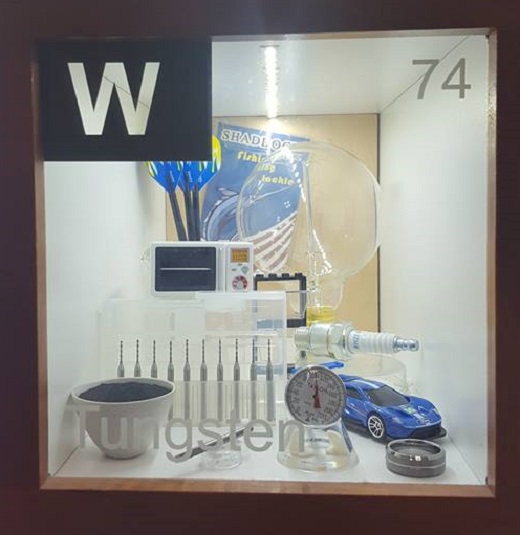Tungsten

Contributor: Olivia Schaffner’s Chemistry class, Edgerton High School
About the Display: This display features:
- Golf club head: Tungsten is used in the heads of some golf clubs because it is very heavy, so it lowers the center of gravity. This helps the ball to be struck more consistently and to give it more speed and better trajectory.
- Wedding ring: Some wedding rings are made of tungsten carbide, the color of which can be changed to various shades of gray, white, or black. Tungsten carbide is tough, scratch-resistant, and non-reactive, and it does not change color, making it ideal for wedding rings. These rings are also cheaper and stronger than gold and platinum rings.
- Drill bits: Tungsten carbide drill bits are one of the most durable types of drill bits because of tungsten’s hardness, and they are used to create holes that are less than one millimeter in size. Though they can be expensive, they will last for a much longer time due to tungsten’s durability.
- Darts: Tungsten is a common metal used for the tip and body of throwing darts because of its good weight-to-size ratio, which enables a heavier but smaller dart to be made.
- Toy microwave: Tungsten is used in the filaments of microwave ovens; an electric current is passed through the filament, which heats up and emits electrons, creating the microwaves that heat our food. Tungsten is an ideal metal to use for these filaments because its extremely high melting point – 6,152°F – allows it to withstand the amount of heat generated.
- Toy race car: Tungsten alloys are often used as ballast in the frame rails of race cars. Extra weight is needed either to lower the center of gravity of the car or to adjust the balance of the car between the front and the rear, but space is confined, so a high-density material is needed. Because tungsten is so dense, a small volume of it has a much greater weight than an equal volume of steel or even lead.
- Spark plug: Spark plugs are part of the ignition system in the engine of a car, used to ignite a mixture of gas and oxygen. They can be made using several different metals, but this particular one has a solid tungsten core, which is ideal because tungsten’s extremely high melting point, as mentioned above, allows it to withstand the high temperatures created by the combustion in the engine.
- Fishing weights: Tungsten has become the most popular amongst all of the different weighted materials used in fishing for several reasons. Its very high density allows it to sink quickly in water, and it is resistant to rusting, as well. It is also non-toxic, which makes it a better choice than its alternative, lead; lead’s toxicity can endanger the fish.
- Lego window: Tungsten compounds are used in glass-to-metal seals, which are used in windows. Tungsten (VI) oxide is the compound used, or lithium tungstate, in cases when the glass contains lithium. The reason these materials are ideal for this use is tungsten’s low thermal expansion.
- Incandescent light bulb: Old incandescent light bulbs typically have tungsten filaments. When electricity passes through the filament, it emits light. Once again, tungsten is used because of its extremely high melting point, allowing it to withstand the heat generated in the light bulb.
- Meat thermometer: There are two wires welded together in a meat thermometer, one of which is generally made of tungsten, due to its extremely high melting point. When the ends of this type of wire are at different temperatures, electricity runs through it, and the amount of electricity indicates the temperature difference between the two ends.
- Tungsten powder (donated by Proto Manufacturing, Inc.) - This powder is incorporated into materials, such as putty or polymers, to make them better radiation shields. The tungsten-enriched material is then placed around an x-ray tube or instrument casing to prevent x-rays from penetrating.
Fun Facts:
- Tungsten has 26 isotopes, 5 of which are stable.
- While tungsten compounds are very strong, pure tungsten is very soft.
- Tungsten was originally named wolfram, which is why its symbol is W.
- In Swedish, tungsten means “heavy stone.”
- Tungsten is the heaviest element that plays a role in biology. As of yet, it’s only known to have a role in prokaryotes and in some enzymes.
- About 61,000 tons of tungsten are produced annually by extracting it from different ores.
- 75% to 80% of the world’s supply of tungsten is controlled by China.
- Tungsten has the highest melting point of all metals.
- Tungsten can be used for trickery, due to its density being the same as gold’s; if a block of tungsten were coated in gold, it would have the same weight as if it were gold and would therefore be mistaken as gold.
About the Contributor: Ms. Schaffner’s 4th period Chemistry class from Edgerton High School in Edgerton, Ohio, has 17 sophomores and juniors in it. Pictured in the front row are Lilli DeLuna, Eric Gruver, Elliot Roth, Kaylee Miller, Madison Smith, and Josh Apt. Pictured in the “middle row” is Connor Thiel. Pictured in the back row are Hailey Ward, Megan Rendleman, Haley Minck, Hunter Hamblin, Carl Blalock, Zach Ivan, Jaron Cape, Heaven Imm, Coral Picillo, and Serina Imm.

About Proto Manufacturing, Inc.: Since its founding in 1967, PROTO Manufacturing has been involved in the development of instrumentation for the characterization for materials. Their x-ray diffraction expertise was established through the application of residual stress and retained austenite measurements and systems. This expertise has since expanded into Laue single-crystal orientation and powder diffractometers, as well as x-ray tubes and custom equipment. For over 30 years PROTO has provided solutions for laboratory, factory, and field environments. These state-of-the-art solutions have served a variety of industries including aerospace, automotive, medical, defense, and other high-tech industries. More information about Proto can be found at http://protoxrd.com/.
Back to the Periodic Table
| |-Onward to the next element!> |
Symbol: W
Atomic Number: 74
Atomic Mass: 183.84 u
Electron Configuration: [Xe]6s24f145d4
Year Discovered: 1783
Discovered By: Fausto and Juan José de Elhuyar


